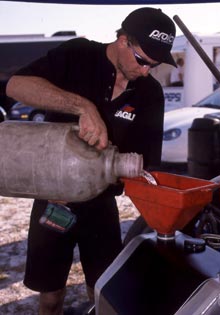DON'T BE FUELISH:
What Those Octane
Numbers Really Mean
by Larry Ericksmoen
 As
a sales rep for VP Racing Fuel in Florida, I get to communicate on a
daily basis with racers and our dealers about their needs regarding
racing fuel. The most common questions we have to deal with pertain
to the octane numbers and to the availability. As
a sales rep for VP Racing Fuel in Florida, I get to communicate on a
daily basis with racers and our dealers about their needs regarding
racing fuel. The most common questions we have to deal with pertain
to the octane numbers and to the availability.
Let's talk octane numbers first. In simplest terms, the octane rating
represents the fuel's ability to resist detonation and/or pre-ignition.
Often times, in a racer's quest to achieve quicker elapsed times they
search out the biggest numbers. More cubic inches, bigger jets, more
boost, but more octane?
When comparing fuel, don't be fooled by the numbers. As I have told
my wife many times, bigger may not be better.
There are two testing methods that gauge a fuel's octane rating. They
are referred to as the research and the motor test. For regular pump
gasoline, these results are displayed as an average of the tests. For
example, pump premium has a 93 octane rating, which is an R+M/2 rating.
Pump octane numbers are what you see on the yellow decal at the gas
stations.
The test criteria and equipment for rating a fuel's octane have remained
the same for about 70 years. The equipment, known as a CFR machine,
has an electric motor, which drives a single-cylinder piston engine.
The combustion chamber is adjustable to allow an increase in compression
ratios. The machine is also equipped with a knock meter.
The research test is performed at 600 RPM; 17 degrees fixed timing
and 100 degrees F inlet temperature. For modern racing engines, these
test conditions are unrealistic; the results are considered by many
to be meaningless. Over the years these numbers have been used more
for advertising, because they are higher numerically, than the motor
octane numbers. Buyers beware!
The motor test is performed at 900 RPM. Ignition timing is advanced
from 17 to 34 degrees, inlet temperatures are increased from 100 to
300 degrees and air-fuel mixtures are leaned.
|